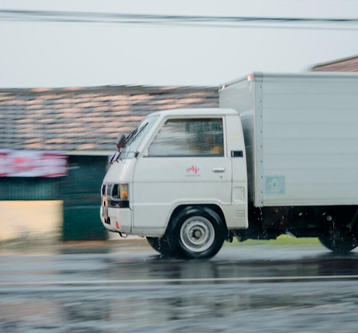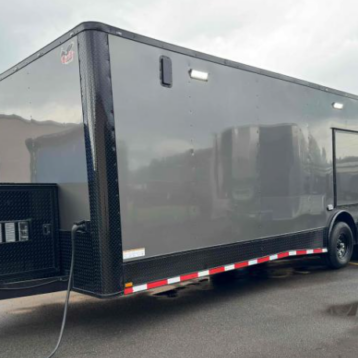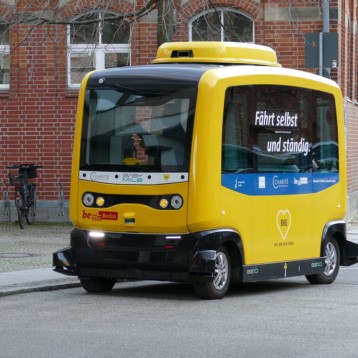Modern mass production methods were first introduced by the automobile industry, but when aviation industries tried to implement them, the ride was not a particularly smooth one.
 |
Drilling the wing of a B-24 bomber at
Consolidated Aircraft Corp., Fort Worth,
Texas (Library of Congress) |
|
Henry Ford brought with his Model T car not only the first affordable and practical car, but also revolutionary production methods for complicated mechanical products. Ford’s Highland Park factory in Michigan, opened in 1910, introduced the modern production line, which enabled mass, and therefore cheap, production of the Model T. This production line was based on a long line of assembly stations that added parts and components to the product as it moved along them. The line moved forward at a predetermined pace, therefore forcing the workers on each station to adhere strictly to the timetable. Conveyor belt were used to move most of the products along the line, as well as to feed it parts. This type of production line was perfectly portrayed in Charlie Chaplin’s classic movie “Modern Times.” By contrast, in the traditional workbench technique most of the manufacturing tasks were performed on static stands by relatively small teams of highly skilled workers.
One of the main benefits of Ford’s production technique was to lower the training level required from the workers. Since most workers performed specific manufacturing tasks that required only relatively brief training, car factories became massive employers of cheap workforces.
 |
Final assembly of B-24 bombers
at the “Willow Run” factory
(National Air & Space Museum) |
|
By the end of WWI several car factories in the USA and elsewhere already used the new production methods introduced by Ford, and other branches of the industry also adopted them. The aviation industry, however, was not among them. Although several countries produced large numbers of aircraft during the war, the aircraft industry stuck to traditional workbench production methods due to the fact that aircraft are complicated and delicate machines that require extremely high precision and care. Furthermore, at the time they were constructed mainly from traditional materials, such as wood and fabric, that were difficult to adapt to the new techniques of the automobile industry.
During the interwar years demand for large numbers of aircraft diminished due to economical difficulties and defense cuts, even though commercial aviation expanded rapidly. The looming clouds of war and massive rearmament in the second half of the 30s brought a change. In Great Britain some of the main concerns occupying the minds of decision makers were aerial threats on the one hand, and the need to take the war to the enemy through bombers on the other. As a result, a large portion of Great Britain’s rearmament was dedicated to modern aircraft. The need to produce large numbers within a short time caused British decision makers to think out of the box. In May 1938 the Air Ministry contracted Lord William Morris, owner and director of Morris Motors Ltd., and pioneer of inexpensive mass-produced cars in Britain, to bring his car manufacturing expertise to aircraft and aero engine production. Nuffield’s most urgent task was to expend the production of the new Spitfire fighter (some people suggested jokingly to change the name of the plane to “Spitfield” or “Nuffire”). He established his first big so-called “shadow factory” at Castle Bromwich, near Birmingham, taking advantage of the presence of several car manufacturers in this area and therefore of the availability of a relatively large pool of skilled workers. In addition, he increased the recruitment of women as a cheap and available workforce. By 1940 his factories became the main producers of British fighters and their engines, using modern production lines; however, British plants continued to produce bigger planes on old fashioned production lines because they were considered to be too complicated for the new system.
 |
final assembly of B-25 medium bombers
at North American’s factory in
Kansas City (Library of Congress) |
|
On the other side of the Atlantic, application of automotive methods to aircraft manufacturing was carried out even further. In May 1940 Henry Ford offered to the US government production of one thousand aircraft of standard design already in production a day. Both the US and British governments, shocked by the quick fall of France, soon started to consult him. His greatest rival, General Motors (GM) also offered to produce aircraft for the United States before the they entered WWII. Both firms influenced the conversion of the American aviation industry to modern production methods while converting some of their own plants to aviation production. GM, in particular, formed a useful and effective partnership with Grumman to produce naval fighters.
The conversion of the car industry into aviation production and the conversion of the aviation industry to a Detroit-like mass production system went far from smooth. Aircraft and aero-engines were much more complicated machines than cars and automakers encountered numerous problems when they tried to mass-produce aircraft with their existing machinery and production lines. Furthermore, by definition, the car industry was far less flexible and was unable to incorporate frequent changes of design that typified military products – particularly military aircraft. This was a major problem typical to military products, which requires an explanation. The whole idea of the Fordian mass production system was to set a production line and let it produce large number of standard product. Any important change in design meant an interruption of the production for retooling and rearrangement of the production line, so civilian manufacturers tended to introduce improvements only in large intervals. In contrast, military production demanded almost constant changes as required by the more dynamic military environment. Battlefield experience demanded constant changes in the design of WWII era warplanes. It was easier to incorporate such changes on the older production lines because in this way it interrupted only part of the production. On the modern production lines retooling and rearrangement of parts of the lines disrupted the entire line.
 |
The huge Spitfire factory in
Castle Bromwich (UK National Archives) |
|
The Americans partially solved the problem by using the “blocks” system, in which several changes and modifications were collected and then incorporated on production “blocks”.
As a result of the problems the American and British aviation industries never fully adopted the mass production methods of the car industry and instead devised as a compromise different flexible production processes. This meant that while some parts and smaller components were produced on conveyor belt production lines, bigger components were still assembled on stationary workbenches. The influence of Ford, General Motors, and Nuffield was still crucial in pushing the aviation industry to seek new ways to increase its output.
The American car industry reached its peak wartime efficiency and publicity with Ford’s one-mile long and 40,000 workers strong “Willow Run Bomber Plant,” constructed in Ypsilanti, near Detroit. It rolled out its first B-24 Liberator heavy-bomber in October 1942. In March 1944 this factory produced 14 Liberators, each made from 1.25 million parts, per day. Ford achieved this rate by redesigning the bomber for ease of manufacture and creating a larger number of production breaks, where work was divided into smaller portions. However, Willow Run also demonstrated the problems of mass-producing complicated warplanes. In contrast to what was portrayed in wartime propaganda, it took around two years to reach reasonable output and the plant suffered from continuous problems during the critical years of 1942-1943. Many of the planes produced at Willow Run went straight to other factories upon leaving the production line in order to receive the latest updates before the US Army Air Force accepted them into service. In early 1943 Willow Run came under congressional scrutiny because of its failures. Senator Harry Truman, chairman of the War Investigating Committee, alleged that production at the plant amounted virtually to none. The nickname “Will It Run” appeared at that time and stuck. Willow Run eventually produced 8,685 Liberator bombers and exemplified what could be achieved by using modern production lines, but it also proved that building a bomber was not at all like building a car.
 |
US Propaganda poster depicting
Rosie the Riveter
(Library of Congress) |
|
Both Nuffield and Ford offered to design their own aircraft and make it easier to produce more aircraft more quickly. Their offers were declined because of their inexperience in aircraft design and they were wisely tasked to produce existing designs. General Motors attempted in 1942-1943 to develop a high-performance heavy fighter using many components from existing aircraft types, significantly cutting down the time it would take to make it ready for mass production. The resulting P-75 Eagle fighter was a complete failure – even after a major redesign. The failure cost the US Army Air Force $49.75 million.
In contrast to the Allies, the Germans were much slower in adopting modern production lines. The main reasons for their failure were mismanagement by the Air Ministry and the reluctance of industrialists and factory managers to disrupt production in order to convert existing production lines. Furthermore, apart from few exceptions, Germany’s modern car industry stayed out of the specialized and exclusive branch of aviation production. Among the few exceptions was Volkswagen, which was contracted to manufacture wing sets for medium bombers and later the cheap and simple V-1 cruise missile. Only after reports about the high production rates of the US aviation industry, and particularly about Willow Run, reached Germany in 1942, the German aviation industry started to modernize its production lines. It was a lengthy process that mostly ended in mid 1943. The German equivalent to Willow Run was supposed to be the “thousand bomber plant,” codenamed “Ultra,” initiated in mid 1942. The plant was never constructed however, due to shifts in production priorities from bombers to fighters, and was finally canceled at the end of 1943. By that time the Germans had already lost the production war.
 |
Compromise at the Volkswagen Fellersleben
factory: highly mechanized production line
using an old fashion layout to manufacture
medium bomber wings (US National Archives) |
|
One of the most important influences of the introduction of modern production methods in the aviation industry was a social one. On the Allies’ side, the drastic cut of training and skill required from production technicians enabled mass recruitment of unskilled women to perform production tasks. Technology played a central role here. The development of easy to operate riveting machines enabled women to operate them after short training. “Rosie the Riveter” became an iconic figure symbolizing the thousands of women that worked in the war industry. It happened also in Great Britain and in the USSR, where simplification of aircraft for easier production became an art.
In Germany the effect of new production technology was more sinister. While German women mostly stayed at home, modern production lines allowed the Germans to employ foreigners from occupied Europe and concentration camp inmates in the production of aircraft. This change was a major factor in the so-called “production wonder” of the German aviation industry in 1944. The “wonder” was a significant increase in aircraft production that was of course useless, because the German air force was already defeated and there were not enough pilots to fly those planes.
 |
Layout of an old fashion Me 109 fighter
wing production by the Erla firm
(US National Archives) |
|
Mass military aviation production disappeared gradually after WWII. One reason was defense cuts and the raising costs of modern aircraft. Ford’s production methods were efficient only for the production of large batches. Another reason was the increasing complication of military aircraft, which made it almost impossible to produce them like consumer goods.
 |
The same production line after
being converted to a flow line in
early 1943 (US National Archives) |
|
There was, however, one sector of the aviation industry that kept producing a regularly large series of easy-to-produce aircraft. The flourishing general aviation market – first in the USA and then elsewhere during the 50s- brought mass production of light aircraft on production lines that resembled the production lines of the automotive industry. Companies like Piper, Cessna, and Beechcraft were major manufacturers of utility aircraft during WWII. In the postwar years the production lines of these giants and of lesser manufacturers started to deliver thousands of light aircraft to the developing civilian market. The ERCO Company, for example, turned out, at a certain time, 34 Ercoupe light planes per day.
Production of modern military aircraft and airliners, however, is far from being simple or straightforward. Automatic and partially robotic production lines, like those common in modern car industry, are not used by the aviation industry. Most modern military and commercial planes are basically being hand made just like they used to be before WWII, but the Detroit dream of mass-produced aircraft still lives on in the general aviation sector.
Further reading:
- Budrass, Lutz, Flugzeigindustrie und Luftrüstung in Deutschland 1918-1945, Düsseldorf: Droste, 1998.
- Braun, Hans-Joachim, “Aero-engine Production in the Third Reich”, in History and Technology 14 (1992), pp.1-15.
- Ferguson, Robert G., “One Thousand Planes a Day: Ford, Grumman, General Motors and the arsenal of Democracy” History and Technology, Vol.21, No.2 (June 2005), pp.149-175.
- Hounshel, David A., From the American System to Mass Production, 1800-1932: The Development of Manufacturing Technology in the United States, Baltimore: John Hopkins, 1984.
- Holley, Irving Brinton jr. „A Detroit Dream of Mass-produced Fighter Aircraft: The XP-75 Fiasco” Technology and Culture 28 (1987), pp.578-593.
- Mommsen, H. Grieger, M, Das Volkswagenwerk und seine Arbeiter im Dritten Reich. Düsseldorf: Econ, 1996.
- Sabel, Charles F.. Zeitlin, Jonathan (eds.), World of Possibilities : Flexibility and Mass Production in Western Industrialization, Cambridge: University Press, 1997.
- Zeitlin, Jonathan, “Flexibility and Mass Production at War: Aircraft Manufacture in Britain, the United States and Germany”, in Technology and Culture, 36 (1995), pp.46-79.
- Michigan Historical Center, Department of History.
About the author: Dr. Daniel Uziel researches different aspects of modern German history, military history, and war and media. In recent years he is researching the history of the German aviation industry. He conducted part of this research as a fellow at the US National Air & Space Museum.
You can find all of Dr. Uziel’s columns on TFOT here.


















